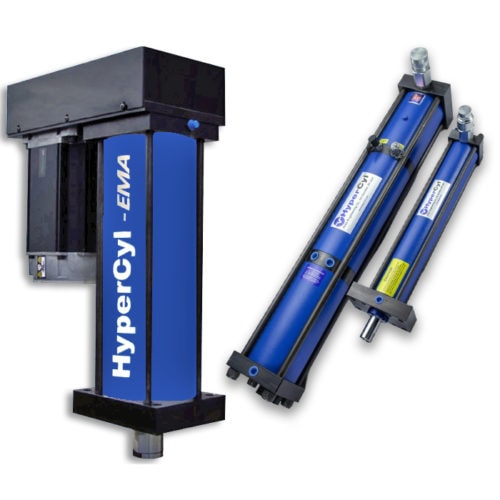
Actuators are mechanical devices that use energy to generate motion. Manual or automatic control commands initiate change in physical systems, creating motion to perform a task. Actuators allow machines to lift, block, clamp, eject and more.
Depending on the type of energy source used to produce motion, three main types of actuators are available: hydraulic, pneumatic and electric. Below we’ll review the characteristics of these actuators as well as their applications and advantages.
Hydraulic Actuators
Known as the most commonly used energy conversion system, hydraulic actuators are an especially popular choice for systems requiring high-force automation equipment. These actuators rely on oil fluid compression.
A variety of heavy-duty applications use hydraulic actuators to produce anywhere from ½ to 4,000 tons of force. These potential applications include:
- Cargo handling
- Large construction equipment
- Military weapons
- Marine propulsion
- Transportation systems
Advantages of Hydraulic Actuators
Hydraulic actuators bring the following benefits to an operation:
- Good strength-to-weight ratio: Hydraulic actuators can deliver tremendous force relative to their weight.
- Safety: They include various safety features, including rod locks, dump valves that quickly dissipate energy, and bypass valves that close off high-pressure oil when generating motion.
- Mobility: Hydraulic actuators are also compact enough to take on mobile operations, servicing trucks and other heavy transportation equipment.
Pneumatic Actuators
Most pneumatic actuators feature compression rates of 80 to 100 psi, making them a more stable and safe option for applications requiring less force. These actuators capture atmospheric air and compress it at higher pressures to generate motion. The specific parts of a pneumatic actuator include the actuator, storage tank, system of delivery hoses, motor and compressor unit.
Advantages of Pneumatic Actuators
The benefits of pneumatic actuators include:
- Speed: The fastest actuators are pneumatic. Fast cycle rates contribute to greater productivity and profit.
- Cost effectiveness: Pneumatic actuators have lower upfront costs compared to other actuators. They return their initial investment quickly, especially for moderate-duty applications.
- Simplicity: Pneumatic actuators are relatively simple, so they are less likely to malfunction and easier to repair if they do.
Electric Actuators
Electric actuators use a motor to convert electric energy into torque, producing motion. They use a variety of mechanical components—gears, planetary roller screws, ball screws, lead screws—to generate linear energy from rotational energy.
Small electric actuators are best for low- to medium-duty applications, such as packaging, factory robotics, automotive manufacturing and medical devices. Large electric actuators can produce up to 50,000 lbs of force.
Advantages of Electric Actuators
Electric actuators provide the following main benefits:
- Speed: Electric actuators respond quickly to generate motion, with speeds of up to 20 in./sec.
- Precision: Unlike hydraulic and pneumatic actuators, electric actuators are highly precise because they are not subject to inherent tolerances.
- Cleanliness: Electric actuators use electricity, a clean energy source, eliminating the risk of leaks.
Electric Actuators from Aries Engineering
Aries Engineering produces the HyperCyl-EMA, one of the most reliable electromechanical actuators on the market. This servo-driven actuator works well for precision assembly applications and as substitutes for hydraulic or pneumatic actuators. Our electric actuators are capable of 0.0025 mm, ram speeds of up to 500 mm/sec, and up to 50,000 lbs of output. The HyperCyl-EMA has served customers in the aerospace, automotive, defense, medical, appliance, electronics and transportation industries.
Find the Actuator You Need at Aries Engineering
Aries Engineering Co., Inc. manufactures a line of “hydra-pneumatic” presses and cylinders for many types of assembly applications. We pioneered oil/air compression in 1994 and continue to serve clients across the manufacturing, industrial automation, defense and commercial industries.
If you would like to find out more about our HyperCyl-EMA electric actuators and other products, contact us today. To get started on your next solution, request a quote at any time.

Comments are closed